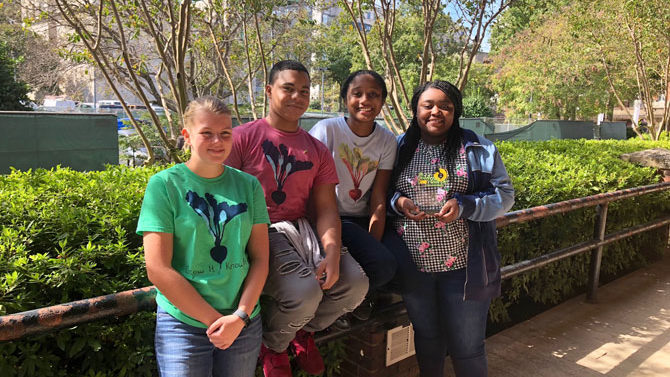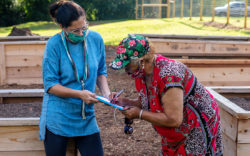Clarke County middle school students are getting an education in gardening, soil sciences, food distribution, marketing and management, thanks to a sustainable agriculture pilot program made possible by a partnership among the school district, UGA and AmeriCorps VISTA, a federal service organization that aims to alleviate poverty. Called Grow It Know It, the three-year pilot program helps students understand the environmental value of producing food locally, and has spawned numerous other local food initiatives that build on its success.
Grow It Know It is the brainchild of UGA horticulture professor David Berle, who earlier had established the UGArden, and the idea emerged more than 10 years ago from a series of discussions on the topic of food with individuals from UGA’s Office of Service Learning, the colleges of Horticulture, Education and Crop and Soil Sciences, and the Athens-Clarke County Extension Service.
The group decided to launch a program that would recruit students to create a series of raised-bed vegetable gardens at the county’s four public middle schools. They envisioned the gardens as teaching opportunities that would support class work in Agriculture Science and Family and Consumer Sciences and launch conversations about sustainability, nutrition and the positive effects individuals can have on the larger social and physical environment.
The schools were encouraged by the response from the students, and the program began to attract kids, some of whom were otherwise not involved in either academics or athletics. Yet initial success was uneven, and they realized that each garden would need dedicated individuals to keep students engaged and provide regular maintenance. To support the effort, Berle suggested that the schools create a partnership that would hire a manager to spearhead the program day to day.
Wick Prichard, a UGA graduate of the school’s environmental program, was hired to serve as a full-time program coordinator, and the garden initiative soon became known as Grow It Know It. The group obtained a grant from AmeriCorps VISTA, which placed two volunteers at each of the four middle schools.
As the program became more successful, teachers saw that some previously disengaged students were perking up and showing interest in the gardens. Gardeners learned about the importance of feeding the soil and set up compost piles that recycled wasted food out of the cafeteria. Since food waste was a big issue at the schools, they created a food recycling cart, with one bin for partially eaten food destined for the compost pile, and another where students place whole pieces of fruit for delivery to the fledgling in-school food pantries to help feed needy students and their families.
From there, numerous other food literacy programs begin to take shape. Prichard organized a summer camp where the gardeners launched a weekly “pop-up restaurant” that served a full lunch, with much of the food coming from the gardens. The pop-up restaurants went on to become “Meals in the Middle” that serve hungry patrons year-round.
At about the same time, Emmanuel Stone launched the Culinary Arts Program, which prepares young chefs for demanding restaurant work. Stone has placed some of these students in jobs at local restaurants, including The National and Last Resort.
Even the school cafeterias have gotten involved and have launched a “farm to school” program that works with local farmers to obtain fresh vegetables.
Adding marketing and management to their new skills, school gardeners went on to pool fresh vegetables grown at the four schools to set up weekly rotating “markets,” setting up tables at school entrances to provide greens for their classmates as they board their buses.
Prichard is encouraged by the enthusiasm he sees, and he credits the success of the program to the students, faculty and staff who have taken part in it. “My ultimate goal and wish and dream would be that these students have the knowledge to become eco-citizens as they move into adulthood,” he says. “They are going to link civics with ecology and nutrition, and it’s going to be second nature to them to see that everything is connected. When they vote, when they shop, when they participate with the school board, they’re going to be thinking of the environmental impact of their decisions.”
Like what you just read? Support Flagpole by making a donation today. Every dollar you give helps fund our ongoing mission to provide Athens with quality, independent journalism.










